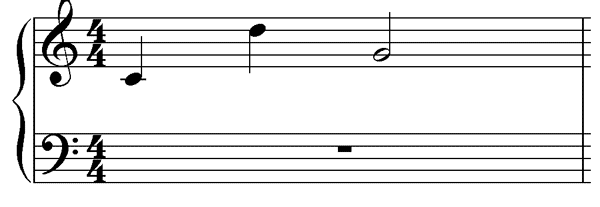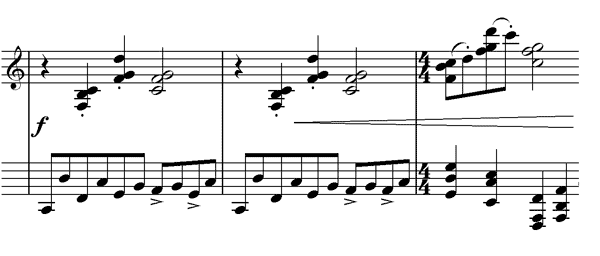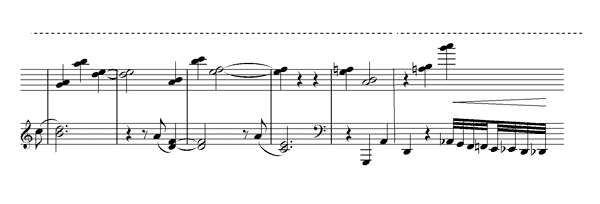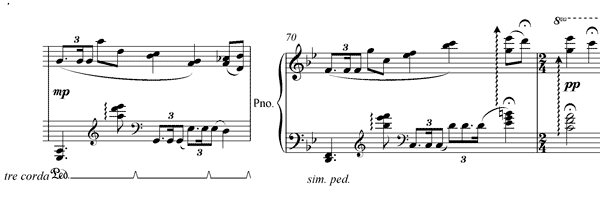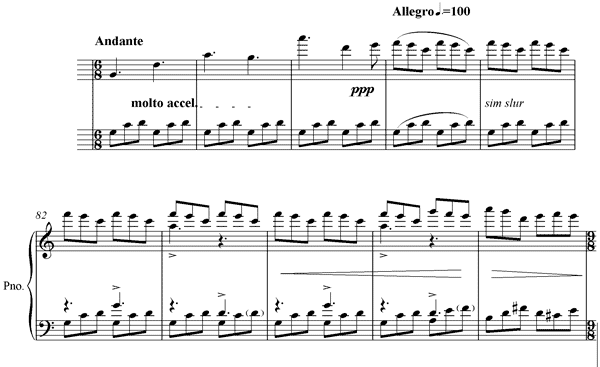
 Translating Gender from Anime to Music
Translating Gender from Anime to Music
— University of Western Sydney
Abstract
As a composer and researcher, my compositions are linked to the research that is conducted during the writing period. My research is focused on how I may translate the design, movement, characterisation and voice acting of Japanese anime into musical expression. For this essay, the exploration of gender theory within anime has forced me to consider to what level music gender theory and anime gender theory combine within my work. I am constantly concerned with how an audience may interpret the musical gestures I compose, similar to how an audience may interpret the gendered actions of the characters and creatures within anime. This essay will explore gender within music, and gender within anime, and will finish with an exploration of one of my compositions. In doing so, this essay also explores an aspect of artistic action research through composition. For McTaggart and Kemmis (1982), “research conducted within – not just on – practice can yield evidence.” This posits my research into a practice-led framework, however, also acknowledges that the process is not sequential; rather the composition and the research affect each other.
Introduction
As a young boy watching my morning cartoons, I noticed two distinctly different styles of animation. One where the eyes were drawn in an understated and realistic way, and one where they were the most expressive part of the cartoon figure’s body: large, colourful and with an unmistakable circle of reflected light. I gravitated to the second style. However, the occasional episode within this style would introduce a character that forced me to question whether or not they were male or female. This second style of animation, which I later learnt was called 'anime’, offers an ambiguous approach to gender. As a composer, of interest to me is whether my music, as it is informed by anime, will reflect different notions of gender.
The question this paper seeks to respond to is: Do dominant notions of gender ideology in anime arise and become translated into compositions which have been informed by anime? I use the term 'translated' as defined by Mildred Larson (1991): to move from one medium to another. My intent is not to discuss the validity of gendered music or propose new theories for defining gendered expression in music, rather my research is into how constructs of gender may be inferred musically and the reverse.
I would now like to describe the suite of pieces that will serve as examples of my own music that has been influenced by anime. The Kawaii Suite is a set of four pieces for piano composed for pianist Antonietta Lofreddo, to be performed in a concert of music with childhood themes. I thought it appropriate to compose pieces based on anime as this was a strong influence in my childhood. Each piece is based upon a selected character/creature from an anime whose intended audience is children.
Here, it is important for me to emphasise that this paper and the research pertaining to gender, occurred post the compositional process. Any and all research into the dominant influences of the music were broader in theme and content and often took the form of me viewing the animation and developing aspects of the particular character. Also, I am not researching anime music but rather focusing on the design, motion and characterisation common to anime. This paper will analyse modes of gender in music limited to the enquiry of tonality and structure. The paper is divided into three sections; firstly establishing a foundation for ideologies of gender within music; secondly, exploring gender within anime; and thirdly, examining one of my compositions in relation to these understandings and responding to the research question.
Gender in Music
There is an intrinsic difficulty when discussing gender within music: one cannot find a common rule for what chords constitute masculine music or which cadences constitute a feminine ending. Rather, the common discourse discusses gender as a construct of society whereby masculinity and femininity are defined by prevailing characteristics and traits. A trait is defined here as an identifiable characteristic. Lunsing (2003) regards gender as a set of constructions determined by culture, time and place. For Horrocks (1994) masculinity, and similarly femininity, has been pluralised at the recognition of the demolition of fixed inviolable categories.
Horrocks writes that masculinity is “fluid” and indeed, on a large scale masculine identities are constantly fluid. As a composer I am interested in how my work, which will be fixed in time, may be viewed as gendered. If gender is a construct, much like a composition, and we are the performers, then surely it is how the audience identifies us that defines us within society. Horrocks claims to be a different person with his female partner, his son, his clients, his father, his mother, his dog. However, is he changing or it is his audience? One could argue both, however unless there is a conscious effort on the part of the performer to alter their performative state, then it is only the audience identification that will result in masculinity or femininity changing.
We must also make a decision about whether gender may be ascribed to non-human objects or experiences, such as music, and humans in different ways. By this, we can infer that as these gendered traits are organised and performed for an audience, all that is masculine is not male and all that is feminine is not female. For Lunsing (2003), the majority of people have at least some attributes (read traits) ascribed to the opposite gender. This reduces gender from a cultural phenomenon to an individual pursuit. Further, gender schema theory, as discussed by Bresnahan (2006), explores how people internalise gender traits based on personal experience. From this perspective, what resonates with me as an artist and composer is the performative elements of gender construction which allow me to infer a musical understanding.
The underpinning theory of recognition and identification outlines both the problematic of gender construction and the reversal of gender identification. Here, I will use a theory by Papastergiadis (2003), who writes that identification is rooted in the act of recognition. That is, that we may identify something or someone as masculine or feminine based upon what we recognise in them and therefore based on our own experiences. This definition is used by Papastergiadis (p45) to explore cultural difference and the act of identifying particular people as belonging to a certain culture. However, I believe the contexts are not dissimilar. We also ascribe identities of gender onto others in the same way after we recognise them as part of our personal definitions. Respecting that once constructed it does not obliterate difference, what we identify as gendered does not restrict the trait from being identified as another aspect of gender by someone else. This understanding speaks strongly to a musical paradigm as sound too is an interpretable construction which, when identified by an audience, is not prevented from being re-categorised and identified by different people. It is this conception of masculine and feminine traits that I see as a foundation for discussion about my music and whether or not the gender ideologies associated with anime may be present in the composition.
It is not my intention to challenge dominant theories of gender, however as a composer I am at liberty to discuss how the harmonic and melodic choices I make may be viewed by an audience or performer. If we are to discuss gender within music, then a proper framework must be set up to contextualise these definitions.
Gender in Anime
Thomas Lamarre (2006) explores how bending gender and gender stereotypes is an intrinsic part of anime and manga subculture. He cites Tezuka Osamu's Metropolis (1949)whichfeatures a man-made human who changes from boy to girl with the flick of a switch. Lamarre goes on to criticise the viewing of anime as having two distinct sub-genres of shonen (boy's genre) and shojo (girl's genre), saying it misses the complexity and subversive attempts of much anime to be accessible to both boys and girls. I will provide examples by exploring the popular franchise Pokemon.
Pokemon experienced its most popular period in the late 1990s. It is a highly addictive franchise of video games, anime, playing cards, stuffed toys and various other miscellaneous merchandise (Tobin, 2004). Pokemon is an abbreviation of 'pocket monsters'. The name references the creatures that inhabit the pokemon world who can be captured and contained in tiny balls. These creatures can be trained for battle, kept as pets, collected or bred. The most predominate function of a pokemon is to train the characters and challenge other players in a battle of strength and strategy. Since the act of fighting is through these agents of strength and skill in the pokemon world, the physical differences, which in normal society have created the taboo of boys fighting against girls, is almost immediately put aside. Men and women are on an equal playing field in this context.
Similarly, objects owned or controlled by the ‘self’ can themselves be seen as gender traits. The franchise seeks to disestablish the kinds of pokemon a particularly feminine woman might have, or equally a particularly feminine man might have. In the anime, the main character, Ash as he is known to western audiences, or Satoshi as he is known to Japanese audiences, is faced with numerous foe that displace gender stereotyping by training or collecting pokemon that would not typically be ascribed to their particular gender identity. This collection of gender traits speaks to me as a musician in the same way that particular instruments may be seen to adhere to particular gender stereotypes, and further the melodies or functions of these instruments.
One of the most well known pokemon is Pikachu, a small yellow rodent-like pokemon who serves as Ash's best friend and sidekick. Pikachu is one of the characters upon whom one of my pieces is based. It represents a gender problematic within anime as it is not convincingly portrayed as male or female, and sits at the two opposing ends of the gender spectrum. In one moment Pikachu may be taking part in a high-octane battle, blasting an opponent with electricity in a flurry of colour and determination, and in the next is sitting with large anime eyes on a toy store shelf being cooed at by numerous Japanese school children. This represents a multitude of gender traits which in many ways play at odds with each other. Regardless of personal identification there is an undeniable difference in gender performance; Pikachu's actions are inconsistently gendered. This leads to the final discussion of whether the issues of gender, masculinity, femininity, as discussed by Wim Lunsing (2003), Roger Horrocks (1994) and Susan McClary (1991), and their relationships with the medium of anime are present in my compositions.
Compositional Analysis
My piece, ‘Pikachu’, is built upon an altered theme and variations form. It is based upon the creature discussed previously, the electric fighting rodent who possesses gender traits of an opposing nature. It is not my intention to apply my own personal definitions of masculine and feminine into the piece. The piece is dominated by a three-note motif which can act as the theme from which different variations occur. As the composer, I can inform that the three-note motif is derived from the three syllables of Pikachu's name. Pokemon only communicate by saying their name, the inflections and emphases they apply being their only way of communicating emotion and meaning. This was an aural act which was inspirational to me. The three-note phrase is built upon the tonic, super-tonic and dominant of the scale and is transposed throughout. These are marked scale degrees with pronounced tonality. Further, the emphasis is on the super-tonic as it is played a ninth above the tonic as opposed to a second above. This implies the name of the piece 'pi-KA-chu'.
I would now like to explore the different guises this motif makes throughout the piece and how they may comment on gender. The first image and sound clip are of the motif alone as it sounds before it is altered or accompanied.
|
Fig 1: Smith, Paul. (2010) Motif from Pikachu.
|
Listen to Soundclip |
The second image and sound clip are how it is heard during the first section of the piece.
|
Fig 2: Smith, Paul. (2010) Extract taken from IV. Pikachu – Kawaii Suite.
|
|
The key area here is ‘Bb, however, the motif is played on ‘C’. This act of being a second away reappears throughout the piece. It is cluttered, hidden within cluster chords, and played rapidly over the non-legato bass in the uneasy 5/4 time signature. This represents the battle, the cry of Pikachu as it charges towards its opponent. Stereotypically associated with masculinity, it must be pointed out that there is no gender bias within pokemon in regard to predisposed strength or aggression. Male and female pokemon may battle each other just as male and female pokemon trainers may battle each other via their pokemon. Masking the motif within this harmony parallels the difficulty in assigning a gender to pokemon as they engage in battle as both creatures act with similar intents, albeit with different strategies, to knock out their opponent.
The third visual and audio example is of the motif as it appears in the third section of the piece, which I will discuss before exploring the second section.
|
Fig 3: Smith, Paul. (2010) Extract taken from IV. Pikachu – Kawaii Suite.
|
|
Here, the motif appears quite openly, has less accompaniment, is softer in dynamic in the higher register of the piano, and is doubled in intervals of a second. This is a starkly different presentation of the motif than in the first. One might ascribe a feminine association with this more gentle declaration of the motif. However, I identify this as a proud statement, rhythmic, grounded within the tonic key area. I would leave it up to each individual audience member to decide whether these attributes are identifiably masculine or feminine or both.
It occurs to me that if Pikachu is to embody these starkly different gender traits whether they be masculine or feminine, there must be a transition period. Lunsing (2003) refers to the transformation period from masculine to feminine, and the motif appears in the second section therefore transitioning between gender traits. As it appears here it is played simply, as crotchets and minims in a steady 3/4 time signature, however it is played against bass trills and prestissimo scale passages, making it somewhat difficult to identify. Soon though, the motif begins to rise and climbs in pitch towards the higher register in which it sits in the third section. Moving from clouded and complicated, to soft and simple, a similar inconsistency to Pikachu's actions. The motif becomes largely drawn between two extremes. This reflects the contradicting gender states of Pikachu.
|
Fig 4: Smith, Paul. (2010) Extract taken from IV. Pikachu – Kawaii Suite.
|
|
In the fourth section we see the accompaniment of the motif move from below the melody to above it. The motif is also augmented into a romantic melody, played legato, while we hear echoes of the rhythmic material in the left hand. Once again, this section reflects the differing gender traits of Pikachu as the harmonic extensions of ninths and twelfths seem to struggle with the strident open fourth in the bass and marked arpeggio above the melody. Similarly, when the melody begins playing crushed seconds, the left hand begins a lilting echo of the triplet pattern from the first beat of the bar.
|
Fig 5: Smith, Paul. (2010) Extract taken from IV. Pikachu – Kawaii Suite.
|
|
The fifth section, acts a coda within the macro structure of the piece. The 6/8 time signature is set up and breaks away towards the end, the lilting three-note repeated passages act as barriers as the notes of the motif move between register.
|
Fig 6: Smith, Paul. (2010) Extract taken from IV. Pikachu – Kawaii Suite.
|
|
It is however, still recognisable as contained within these two harmonic walls which act as symbols for the gender traits which the motif bounces to and from.
As a composer choosing to explore this character in music, I am aware that the gendered state of my music will also be informed by that of Pikachu. Separate from my own gender and gender aesthetic, once I begin to attribute differing musical ideas to the visuals and personality of a character, the dynamic of those musical ideas takes on a partnership between myself and the source material. The extreme separation of melodic and structural ideas being held together with the theme is a fusion of differing gendered qualities. This piece is not an example of different themes which represent different gender identities, but rather one theme which is dressed in different guises or performing different functions. The way these different guises are ascribed gender by an audience during the piece’s performance would not be dissimilar from an anime audience ascribing gender onto Pikachu in its various forms. The piece of music therefore, has been informed at an aural and observable level by the gender traits of the visual source material.
Discussion
Gender allusions were not present in my mind at the time of writing the piece. Rather, I was concerned with constructing a musical picture of Pikachu’s personality, role and appearance. However, through the act of inspiration I have in ways, also created an image of Pikachu’s gender and used aspects of gender from other anime. This exploration of gender in music and anime can only be defined from my consciousness. I see and hear my art though my ears and hear aspects which few other people may understand because I alone am privy to the intimate construction of the piece. Does this inhibit my ability to objectively assess gender within my own music? I would contend not. Gender is now a personal construct. Drawing on a model of Papastergiadis’ (2003) cultural discourse, gender is defined by personal identification and thus the gender observations I apply to my own pieces and similarities with anime therein are valid.
When discussing gender in music in such broad terms, problems may arise. One is that any theme and variations within a piece may represent this agendered application of differing gender guises to a theme. However, the reason I adopted this form was because it could aptly represent the changing gender traits of Pikachu. It would also have seemed too simplistic for me to judge my pieces based on stereotypical gender traits and introduce the possibility of masculinities and femininities being able to be identified by the audiences of the music. I could have spoken about the dominant and super tonic scale degrees representing traditional masculine ideals and that once they are contained by the accompaniment within the fifth section of the piece, that this represents Pikachu’s binary gender. However, the nature of such an argument ignores contemporary discussions into gender moving away from societal gendered states of being.
The research for this essay has drawn from various fields in an attempt to create a vocabulary from which a better understanding of the relationship between not only the composer-performer-audience triangle, which has dominated musical production discourse, but that of the composer’s reliance of inspirational material. How might a composer work against gender traits intrinsic to a source material, or should he or she? This essay raises many questions but aims to act as a foundation from which the changing way we identify gender, and as artists and audiences the level to which we are affected by its perception and persuasion, can be discussed.
Bibliography
Bresnahan, Mary Jang, Yasuhiro Inoue, Naomi Kagawa. (2006) Players and Whiners? Perseptions of Sex Stereotyping in Anime in Japan and the US. Asian Journal of Communication. Vol 16 No 2. 207-217
Horrocks, Roger. (1994) Masculinity in Crisis. London: The Macmillan Press.
Kemmis, S. McTaggart, R. (1982) The Action Research Planner. Waurn Ponds Victoria: Deakin University.
Lamarre, Thomas. (2006) Platonic Sex: Perversion and Shojo Anime. Animation: An Interdisciplinary Journal. Vol 1 No 1. pp 45-59.
Larson, Mildred. (1991) Translation: Theory and Practice Tension and independence. Birmingham, New York Press.
Lunsing, Wim. (2003) What Masculinity?: Transgender Practices among Japanese 'Men' in Men and Masculinities in Contemporary Japan. Ed. James Roberson and Nobue Suzuki. RoutledgeCurzon.
McClary, Susan. (1991) Feminine Endings: Music Gender and Sexuality. Minneapolis: University of Minneapolis Press.
O'Neill, Susan A. (1997) Gender and Music in The Social Psychology of Music Ed. David J Hargreaves and Adrian C North. Oxford: Oxford University Press.
Papastergiadis, Nikos. (2003) Complex Entanglements, Art, Globalisation and cultural difference, London: Rivers Oram Press.
Tobin, Samuel. (2004) Masculinity, Maturity and the End of Pokemon in Pikachu’s Global Adventure Ed. Joseph Tobin. Durham: Duke University Press.
About the author
Paul Smith is currently completing a Doctorate of Creative Arts at the University of Western Sydney exploring anime through a folio of compositions. In 2009, he completed his Bachelor of Music (Honours) exploring video games through composition. Paul is a prominent musician in the Blue Mountains west of Sydney composing/arranging for, performing with and coaching multiple local performers. As a singer, he has been awarded scholarships by the Opera Australia Audition's committee, won the Penrith Eisteddfod Recital Prize, performed around the greater Sydney Area with Indigo Opera and is a principal singer with newly established Opera Prometheus. To date his music has been heard in Australia, China, Italy and the US.
Contact: 16131907@student.uws.edu.au
